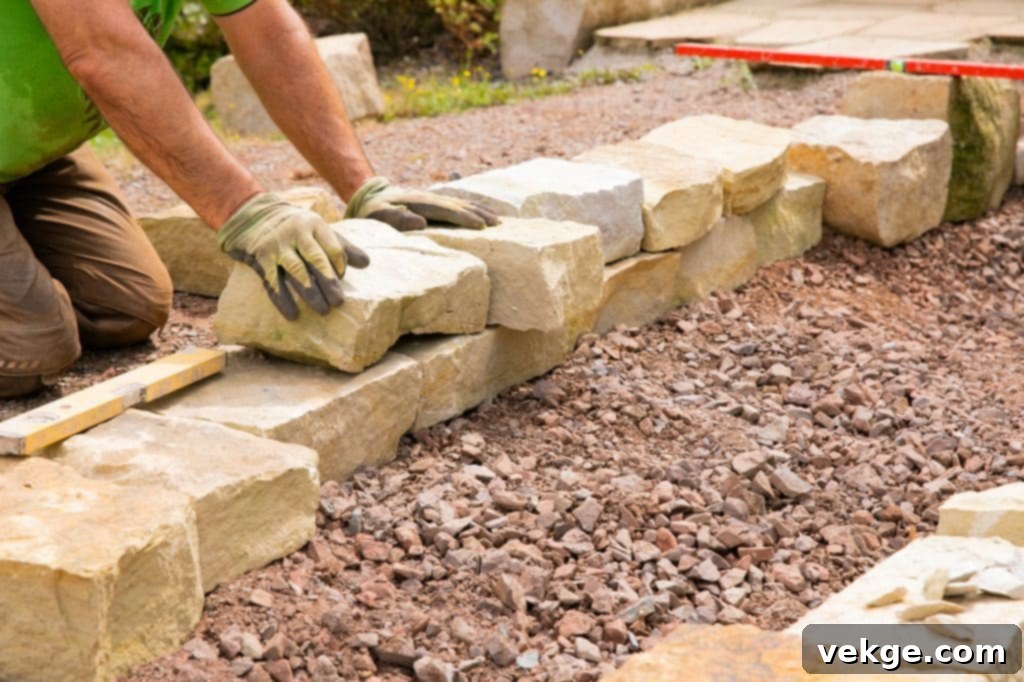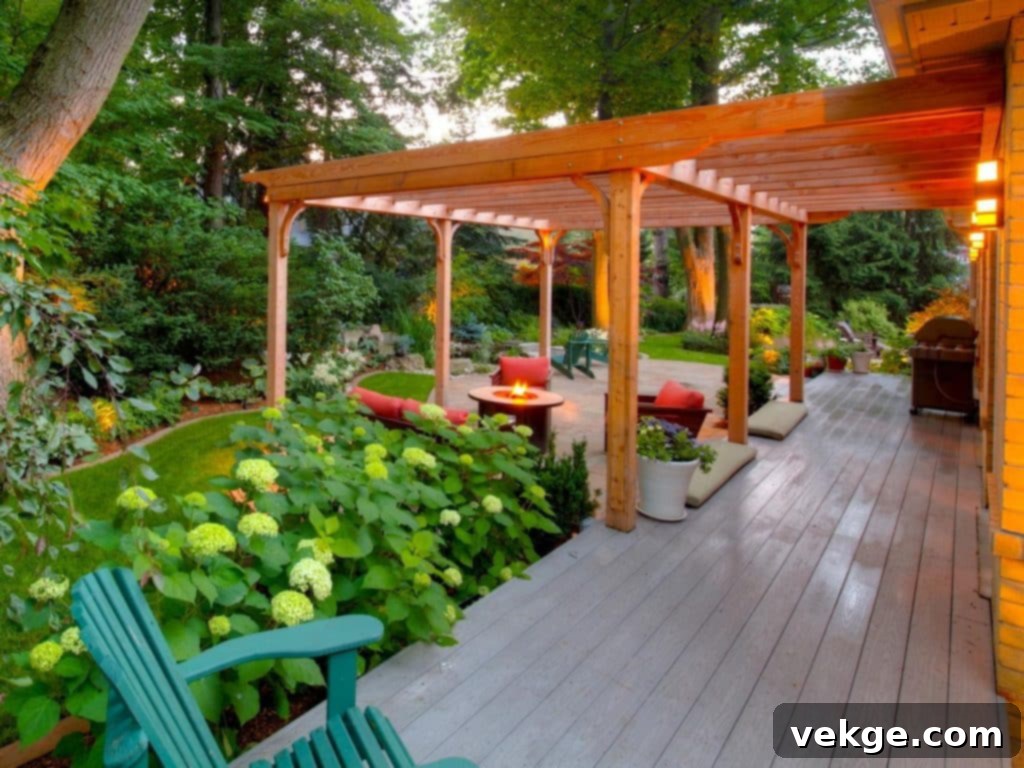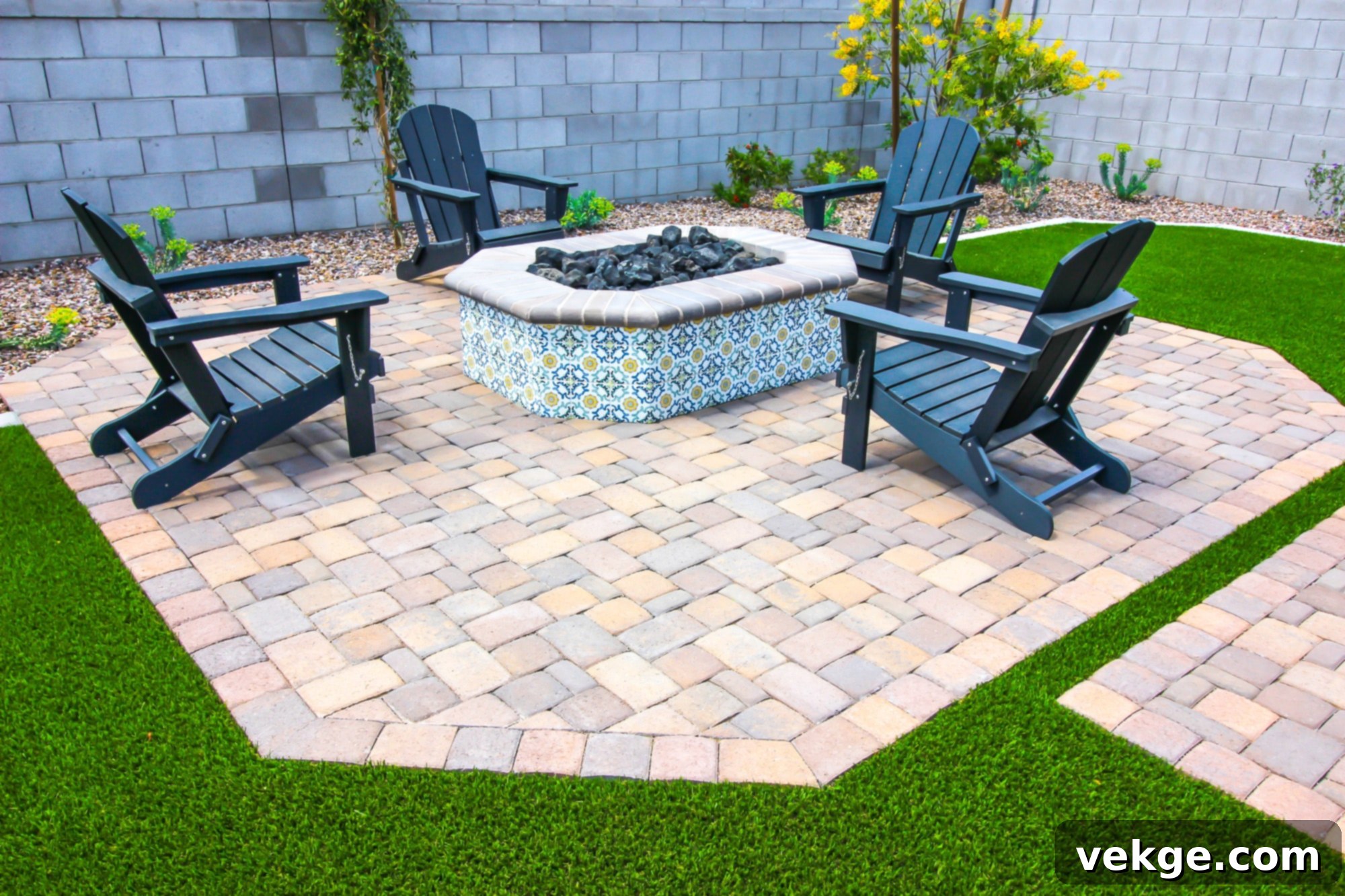Unlock Your Yard’s Potential: Aesthetic & Sustainable Backyard Design with Natural Materials
Have you ever looked at your yard and felt it needed a significant upgrade? Imagine stepping outside and being greeted by a vibrant, inviting space that instantly uplifts your spirit, rather than a dull garden that leaves you feeling uninspired. If this resonates with you, you’re certainly not alone. The condition of your outdoor space has a profound impact not only on your personal well-being but also on how your property is perceived by neighbors, guests, and potential buyers.
A home’s overall attractiveness is frequently judged by its exterior appearance. This “curb appeal” isn’t just about aesthetics; it has tangible benefits. For instance, a meticulously maintained lawn and thoughtful landscaping can significantly boost your home’s market value by as much as 20%. Properties boasting excellent curb appeal can even sell up to 7% higher and much faster than those lacking exterior charm. (1)
Regardless of whether you’re planning to sell your property in the near future, investing in a vibrant and well-designed backyard always yields rewards. A beautiful outdoor space instantly elevates your mood, provides a serene retreat, and reflects your dedication to your home and its surroundings. It’s a statement of pride and a personal sanctuary all in one.
So, if you’ve been contemplating an exterior upgrade, consider making a significant shift towards using natural products. These materials are a true game-changer! They offer an incredible opportunity to transform a lackluster yard into a breathtaking, aesthetic backyard without compromising environmental integrity. By harnessing the beauty and durability of nature’s offerings, you can create a space that is both visually stunning and ecologically responsible. Continue reading to explore some valuable backyard ideas using these remarkable eco-friendly design elements.
Organic Product Options for an Aesthetic and Sustainable Backyard
Nature provides an abundant selection of renewable and readily available resources that can be ingeniously incorporated into our home landscapes. The key to successful design lies in identifying the perfect materials that align with your aesthetic vision and functional requirements. Here are some of the most popular and versatile choices:
Natural Stones for Pathways, Stairs, and Walls

Natural stones, meticulously sourced from quarries and expertly crafted by skilled artisans, introduce an unparalleled touch of rustic elegance and enduring beauty to any outdoor setting. Their inherent durability ensures longevity, while their diverse textures and colors offer endless design possibilities. These versatile materials are often sold as paver stones, available in an extensive array of shapes, sizes, and natural hues—from the sophisticated, smooth finish of slate to the rugged, textured appeal of flagstone, granite, bluestone, or limestone.
Pro Tips for Stone Applications
Consider installing paver stone walkways to craft inviting pathways that gracefully guide visitors through your lush landscape. To create a captivating visual focal point, experiment with contrasting colors or patterns in your stone arrangement. For an extra touch of charm and sensory delight, incorporate low-growing, fragrant herbs like thyme or creeping phlox between the pavers, softening the hard edges and adding a burst of greenery.
Thinking about a raised garden bed? You can construct a stunning one using stacked flagstone, which provides both visual interest and excellent drainage for your plants. Alternatively, build a robust retaining wall with weathered granite boulders to manage sloping terrain or define different garden areas. These elements not only add structural integrity but also infuse your yard with a timeless, natural aesthetic.
If your yard features challenging elevation changes or gently sloping terrain, custom-designed stone stairs offer a solution that is both highly functional and exquisitely aesthetically pleasing. These steps seamlessly blend into your outdoor environment, enhancing visual appeal while providing a safe, sturdy, and elegant passage that allows you to navigate your yard with ease and grace. The natural variations in stone ensure that no two steps are exactly alike, adding to the unique character of your landscape.
Sand and Gravel as Functional Fillers and Design Elements
Formed from the natural breakdown of larger rocks, sand and gravel are fundamental components in the construction industry. In 2021 alone, the United States produced an astounding one billion tons of these sediments, with a cumulative value reaching USD$9.9 billion. While traditionally recognized for their extensive use in foundational building projects and road construction, sand and gravel possess remarkable potential for creative exterior upgrades in your backyard. (2)
Beyond their practical applications, sand and gravel can provide crucial visual separation or artfully highlight various landscaping elements. Strategically placing them around garden beds, or between pavers in high-traffic areas, introduces a delightful contrasting texture to your overall landscape design. When used thoughtfully, these materials also significantly improve drainage in areas prone to waterlogging, helping to prevent soil erosion and maintain plant health. Moreover, for homeowners seeking a low-maintenance alternative to traditional lawns, replacing grass with a stylish gravel bed can dramatically reduce water consumption and upkeep.
Pro Tip for Sand and Gravel Designs
Desire to create a warm and inviting outdoor social space? Design a natural gravel patio, perfect for gathering around a cozy fire pit crafted from stacked stones. A generous layer of pea gravel or decomposed granite provides a stable, permeable, and stylish surface for seating, making it an ideal spot for evening relaxation and entertaining. This combination not only looks fantastic but also offers excellent drainage, ensuring your patio remains usable even after a rain shower. Consider incorporating a dry creek bed using larger river rocks and smaller gravel to manage water runoff creatively and add a striking visual feature to your yard.
Wood for Multiple Outdoor Structures

Wood, with its natural warmth and versatility, is an indispensable material for crafting a variety of outdoor structures that enhance both the functionality and beauty of your backyard. If you frequently enjoy lounging outdoors or have a pool, constructing privacy fences from durable wood like cedar or redwood is highly recommended. These fences not only shield you from curious glances but can also serve as fantastic growing platforms for trailing plants, effectively doubling as an elegant vertical garden feature.
Another excellent application for wood is in creating raised garden beds. Placing your plants within sturdy wooden boxes helps to minimize soil erosion, provides better control over soil quality, and makes gardening more accessible. Larger wooden structures such as elegant pergolas, expansive decks, charming terraces, picturesque gazebos, and inviting patios can dramatically expand your usable living space. These additions allow you to host gatherings, entertain guests, or simply relax in style, transforming your backyard into a true extension of your home. When choosing wood, prioritize sustainably sourced options, such as FSC-certified timber, to ensure your beautiful structures are also environmentally responsible.
Pro Tip for Wood Construction
While simple wooden garden boxes or trellises are relatively easy DIY projects, crafting more complex structures like a multi-level deck, a custom pergola, or a sturdy gazebo often demands advanced carpentry skills and a keen understanding of structural integrity. For these more ambitious backyard landscaping ideas, consulting with or hiring experienced contractors specializing in outdoor wood construction can ensure both the safety and aesthetic perfection of your new additions. They can help navigate local building codes and design a structure that perfectly complements your home and landscape.
Mulch to Protect Your Plants and Enhance Aesthetics
Composed of organic materials like leaves, shredded wood bark, and wood chips, mulch acts as nature’s ultimate protective blanket for your garden soil. It offers a multitude of benefits for both your plants and you, the busy gardener. Applied correctly, mulch effectively insulates the ground, significantly retaining soil moisture and reducing the need for frequent watering. Crucially, it also suppresses weed growth, saving you countless hours of tedious weeding and allowing your desirable plants to thrive without competition.
Beyond its multi-purpose wonders, mulch also contributes significantly to the aesthetic appeal of your yard. It comes in an attractive array of natural shades, including various browns, rich reds, and deep blacks, which beautifully contrast with the vibrant greens of your surrounding foliage. When artfully placed on top of your garden beds, around the bases of trees, and beneath shrubs, mulch instantly enhances your yard’s natural beauty, creating a clean, polished, and cohesive look. Looking to fill the gaps in your paved walkways or create a soft border? Mulch can certainly do the trick, adding texture and a subtle pop of natural color.
Pro Tip for Mulch Application
Ditch the rigid, often unappealing, plastic edging and instead opt for free-flowing, organic mulch borders. Define the perimeter of your flower beds or pathways with a gracefully curved edge of colorful mulch, creating a softer, more natural, and inviting look. This approach allows the garden to blend more harmoniously with the surrounding landscape, enhancing its organic charm. Ensure you apply a layer of mulch that is 2-4 inches deep for optimal benefits, taking care not to pile it directly against tree trunks or plant stems, as this can trap moisture and cause rot.
Compost for a Lush, Nutrient-Rich Garden and Lawn

Compost is truly the unsung hero behind every thriving, vibrant yard. Often created from humble kitchen scraps, yard waste, and other organic matter, it transforms into a nutrient powerhouse for your soil. The decomposed organic matter enriches soil structure, improves drainage and aeration, and provides essential macro- and micronutrients, fostering healthy plant growth and promoting a robust, sustainable ecosystem. Regular use of compost cultivates a rich, living soil teeming with beneficial microorganisms, which in turn leads to stronger, more resilient plants.
Beyond its direct benefits to your garden, composting also plays a crucial role in reducing municipal waste management costs and environmental impact. A compelling 2022 study estimated that by increasing the compost-to-waste ratio to 18%, the United States could annually save 30 tons of carbon emissions while simultaneously cutting a staggering USD$16 billion in municipal waste management expenditures. (3) This highlights the immense economic and ecological benefits of adopting composting practices.
So, if you haven’t already, consider starting a compost pile or bin in your backyard. Collect organic debris from your kitchen (fruit and vegetable scraps, coffee grounds) and yard (leaves, grass clippings). Maintain a good balance of “greens” (nitrogen-rich) and “browns” (carbon-rich), aerate your pile regularly by turning it, and keep it consistently moist but not waterlogged. After a few weeks or months, depending on your method, you’ll have rich, dark compost ready to mix with soil for raised beds before the planting season or to top-dress existing areas.
Pro Tip for Maximizing Compost Benefits
For newly seeded areas, once seeds have germinated, a light layer of mulch on top of your compost-rich soil will help retain moisture and protect young seedlings. Otherwise, liberally sprinkle finished compost onto your lawn, work it into your garden beds, and add it to your potted plants. This will encourage lush, vibrant growth that not only makes your garden flourish but will also undoubtedly leave your neighbors green with envy over your healthy, thriving landscape.
Native Plants: The Foundation of an Eco-Friendly Garden
While it might be tempting to cultivate exotic and unique vegetation to create an aesthetic backyard, choosing plants native to your specific community or region offers far greater benefits for the environment and your local ecosystem. By incorporating endemic plants, you provide vital food sources and essential shelter for local wildlife, including pollinators, birds, and beneficial insects, thereby actively preserving and enhancing biodiversity.
Opting for native plants also translates into significant savings in time, resources, and effort for you. These plants are perfectly adapted to your local climate, soil conditions, and rainfall patterns, meaning they naturally require less water, fertilizer, and pest control to thrive. Their inherent resilience reduces the need for constant intervention. Moreover, native plants often attract natural pest controllers like ladybugs, lacewings, and predatory wasps, which help to keep unwanted garden critters at bay without the need for harmful chemical pesticides. This creates a healthier, more balanced garden environment.
Pro Tip for Incorporating Native Plants
If you’re new to gardening or unfamiliar with your local flora, it’s highly recommended to familiarize yourself with the native plant communities in your region before you start planting. Visit local botanical gardens, nature centers, or consult with native plant nurseries. They can provide valuable guidance on species best suited for your specific site conditions (sunlight, soil type, moisture levels). Remember, while many native plants are low-maintenance, some may have specific requirements that are best understood to ensure their successful establishment and long-term health. Start with a few well-chosen species and gradually expand your native plant palette.
Additional Tips for Using Natural Products to Amplify Your Yard’s Aesthetics
While the judicious incorporation of natural products forms the fundamental bedrock of a truly stunning and sustainable outdoor space, there are supplementary design tricks that can significantly amplify your yard’s aesthetic appeal and functionality. Embrace these simple yet incredibly impactful tips to elevate your landscape:
- Create Captivating Focal Points: Introduce eye-catching elements that naturally draw the gaze and provide a sense of direction within your landscape. This could be a serene small pond, a rustic yet elegant water feature crafted from natural stone, or a striking sculptural piece fashioned from reclaimed wood or carefully chosen boulders. To ensure these focal points remain visible and impactful even after dusk, strategically install subtle outdoor lighting that highlights their beauty and extends the usability of your yard into the evening hours.
- Embrace Dynamic Texture and Contrast: A visually rich garden thrives on variety. Combine plants with differing leaf textures, from the soft, velvety feel of lambs’ ear to the spiky, architectural form of an agave. Don’t shy away from juxtaposing colors and shapes to create compelling depth and dimension. For instance, pair plants with bold, dark foliage alongside delicate, brightly colored blooms to create a vibrant and engaging scene. Incorporate varied hardscaping materials like smooth river stones against rough-hewn timber to add another layer of sensory interest.
- Appreciate Raw, Untamed Beauty: Infuse your yard with scattered natural accents that celebrate the inherent beauty of unrefined elements. River rocks, pieces of weathered driftwood, or uniquely shaped stones can be strategically placed to complement your landscape’s natural contours and features. These elements can also serve dual purposes; for example, a thoughtfully arranged stack of large stones or a line of artistic driftwood pieces can subtly define a border or even double as a natural, permeable privacy screen. These touches foster a powerful sense of harmony with the surrounding environment, making your garden feel integrated and authentic.
Remember, sometimes the simplest and most organic things create the most profound impact. When integrating natural elements into your backyard oasis, don’t always strive for rigid perfection. Instead, embrace the imperfections and unique characteristics of nature. However, do ensure that your outdoor design choices aesthetically align with your interior design motif. This thoughtful coherence creates a unified, harmonious living space that seamlessly extends from inside your home to the great outdoors, enhancing both comfort and visual flow.
Your Sustainable Sanctuary Awaits
Creating an aesthetic backyard is, indeed, a project that deeply intertwines beauty with environmental responsibility. By consciously choosing to stick to natural materials, you not only get to highlight the inherent, timeless beauty of your property but also actively contribute to the well-being of Mother Earth. These sustainable choices minimize environmental impact, reduce waste, and promote local ecosystems. Take this comprehensive guide to heart as you embark on the rewarding journey of transforming your outdoor space into a captivating haven that is simultaneously appealing, functional, and profoundly good for the planet. Your personal, sustainable sanctuary is within reach, promising years of beauty and tranquility.
References
1. Williams, Terri. ‘The Best Ideas To Boost your Home’s Curb Appeal’. August 14, 2023. Accessed online.
https://www.forbes.com/sites/terriwilliams/2023/08/14/the-best-ideas-to-boost-your-homes-curb-appeal/?sh=7760b2d6142d#:~:text=A%20Well%2DKept%20Lawn&text=In%20fact%2C%20he%20tells%20us,by%20up%20to%2020%25.%E2%80%9D
2. Willett, Jason Christopher. ‘Sand and Gravel (Construction)’. US Geological Survey Mineral Commodity Summaries. January 2022. Accessed online. https://pubs.usgs.gov/periodicals/mcs2022/mcs2022-sand-gravel.pdf
3. Farhidi, Faraz, et al. ‘How the US Economy and Environment can Both Benefit From Composting Management’. October 15, 2022. Accessed online. https://www.ncbi.nlm.nih.gov/pmc/articles/PMC9575438/
